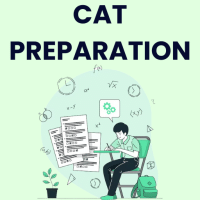CAT Exam > CAT Questions > They are ___________ their coats..a)notb)put ...
Start Learning for Free
They are ___________ their coats..
- a)not
- b)put on
- c)putting on
- d)doesn't put
Correct answer is option 'C'. Can you explain this answer?
Most Upvoted Answer
They are ___________ their coats..a)notb)put onc)putting ond)doesnt pu...
This is present continuous tense
thus here is, am, are helping verb exist with added ing in base form of main verb.
So correct answer is c
that is They are putting on their coats..
thus here is, am, are helping verb exist with added ing in base form of main verb.
So correct answer is c
that is They are putting on their coats..
Free Test
FREE
| Start Free Test |
Community Answer
They are ___________ their coats..a)notb)put onc)putting ond)doesnt pu...
Explanation:
The correct answer is option 'C' - putting on.
Subject-verb agreement:
In the given sentence, the subject "they" is plural, so the verb should also be plural. The correct form of the verb "to put on" in the present continuous tense for the subject "they" is "are putting on."
Usage of the present continuous tense:
The sentence is talking about an ongoing action, indicating that the people referred to as "they" are currently in the process of putting on their coats. The present continuous tense is used to describe actions happening at the moment of speaking or actions that are currently in progress.
Contractions:
In the given options, contractions are used to form the verb phrase. The contraction of "are" and "not" is "aren't." However, in the sentence, there is no negation mentioned. Therefore, option 'A' - not is incorrect.
Subject-verb agreement:
Option 'D' - doesn't put is incorrect because "doesn't" is the contraction of "does not," which is used for the singular subject. In the given sentence, the subject "they" is plural, so the verb "does not put" is not grammatically correct.
Correct option:
Option 'C' - putting on is the correct answer because it agrees with the subject "they" and correctly uses the present continuous tense.
The correct answer is option 'C' - putting on.
Subject-verb agreement:
In the given sentence, the subject "they" is plural, so the verb should also be plural. The correct form of the verb "to put on" in the present continuous tense for the subject "they" is "are putting on."
Usage of the present continuous tense:
The sentence is talking about an ongoing action, indicating that the people referred to as "they" are currently in the process of putting on their coats. The present continuous tense is used to describe actions happening at the moment of speaking or actions that are currently in progress.
Contractions:
In the given options, contractions are used to form the verb phrase. The contraction of "are" and "not" is "aren't." However, in the sentence, there is no negation mentioned. Therefore, option 'A' - not is incorrect.
Subject-verb agreement:
Option 'D' - doesn't put is incorrect because "doesn't" is the contraction of "does not," which is used for the singular subject. In the given sentence, the subject "they" is plural, so the verb "does not put" is not grammatically correct.
Correct option:
Option 'C' - putting on is the correct answer because it agrees with the subject "they" and correctly uses the present continuous tense.

|
Explore Courses for CAT exam
|

|
Question Description
They are ___________ their coats..a)notb)put onc)putting ond)doesnt putCorrect answer is option 'C'. Can you explain this answer? for CAT 2025 is part of CAT preparation. The Question and answers have been prepared according to the CAT exam syllabus. Information about They are ___________ their coats..a)notb)put onc)putting ond)doesnt putCorrect answer is option 'C'. Can you explain this answer? covers all topics & solutions for CAT 2025 Exam. Find important definitions, questions, meanings, examples, exercises and tests below for They are ___________ their coats..a)notb)put onc)putting ond)doesnt putCorrect answer is option 'C'. Can you explain this answer?.
They are ___________ their coats..a)notb)put onc)putting ond)doesnt putCorrect answer is option 'C'. Can you explain this answer? for CAT 2025 is part of CAT preparation. The Question and answers have been prepared according to the CAT exam syllabus. Information about They are ___________ their coats..a)notb)put onc)putting ond)doesnt putCorrect answer is option 'C'. Can you explain this answer? covers all topics & solutions for CAT 2025 Exam. Find important definitions, questions, meanings, examples, exercises and tests below for They are ___________ their coats..a)notb)put onc)putting ond)doesnt putCorrect answer is option 'C'. Can you explain this answer?.
Solutions for They are ___________ their coats..a)notb)put onc)putting ond)doesnt putCorrect answer is option 'C'. Can you explain this answer? in English & in Hindi are available as part of our courses for CAT.
Download more important topics, notes, lectures and mock test series for CAT Exam by signing up for free.
Here you can find the meaning of They are ___________ their coats..a)notb)put onc)putting ond)doesnt putCorrect answer is option 'C'. Can you explain this answer? defined & explained in the simplest way possible. Besides giving the explanation of
They are ___________ their coats..a)notb)put onc)putting ond)doesnt putCorrect answer is option 'C'. Can you explain this answer?, a detailed solution for They are ___________ their coats..a)notb)put onc)putting ond)doesnt putCorrect answer is option 'C'. Can you explain this answer? has been provided alongside types of They are ___________ their coats..a)notb)put onc)putting ond)doesnt putCorrect answer is option 'C'. Can you explain this answer? theory, EduRev gives you an
ample number of questions to practice They are ___________ their coats..a)notb)put onc)putting ond)doesnt putCorrect answer is option 'C'. Can you explain this answer? tests, examples and also practice CAT tests.

|
Explore Courses for CAT exam
|

|
Signup for Free!
Signup to see your scores go up within 7 days! Learn & Practice with 1000+ FREE Notes, Videos & Tests.


















